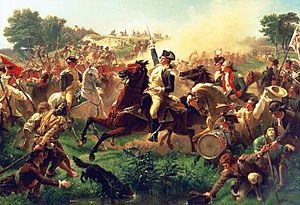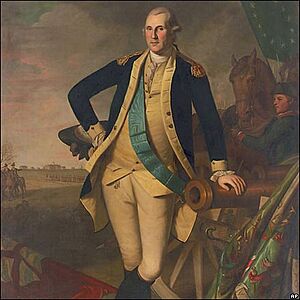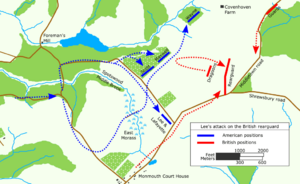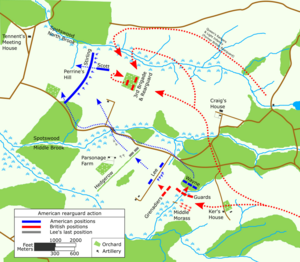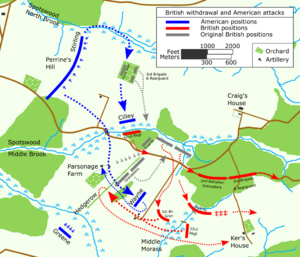Battle of Monmouth facts for kids
The Battle of Monmouth, also called the Battle of Monmouth Courthouse, happened on June 28, 1778. It was an important fight during the American Revolutionary War. In this battle, the Continental Army, led by General George Washington, faced off against the British Army in North America, led by General Sir Henry Clinton.
Contents
Why the Battle Happened
The British Army, led by General Sir Henry Clinton, was leaving Philadelphia. They had been in the city for almost a year. Their plan was to go north to New York City, which was their main base in America. General George Washington, who was the commander of the Continental Army, wanted to stop them. He ordered his soldiers to follow the British. Washington hoped to surprise them and deal a big blow.
The British army was very large, with about 15,000 soldiers. Washington's army was smaller, with about 11,000 soldiers. But they were very determined.
Where the Battle Took Place
The battle happened near Monmouth Courthouse. This area is in present-day New Jersey. Imagine a wide, open field under a hot, sunny sky. The summer heat on that day was a big problem. It made the fighting even harder for the soldiers.
The Commanders
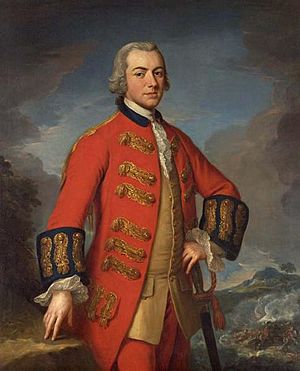
On one side was General George Washington. He was the inspiring leader of the Continental Army. Washington was known for his courage and smart plans. He was determined to win the war for American independence. He always found ways to motivate his soldiers, even when things were tough. The Battle of Monmouth was a good example of this.
On the other side was General Sir Henry Clinton. He led the British forces. Clinton was a careful commander. He focused more on keeping his army safe than on attacking. This difference in their leadership styles would affect how the battle turned out. Clinton really wanted to reach New York without any more big fights.
How the Battle Started
The battle began around noon on June 28. An advance group of Washington's army, led by General Charles Lee, was told to attack the British rear guard. But this first attack did not go as planned. The British, led by General Charles Cornwallis, quickly pushed Lee's soldiers back. There is some debate about what exactly happened. Some people thought Lee's troops retreated too soon.
General Washington himself arrived and was very angry about the retreat. He quickly gathered his men and got them ready to fight again.
The battle continued with both sides using cannons, muskets, and bayonets. The heat grew even stronger, making the fighting extremely difficult. Many soldiers became very tired from the sun and dehydration.
Washington's Leadership Moment
Washington rode right into the middle of the battle. He saw his soldiers struggling. He personally encouraged them, shouting orders and telling them to fight back. He showed amazing leadership. His actions inspired his soldiers to overcome their early problems. They pushed back against the British.
A Tough Fight
The fighting went on through the late afternoon. Both armies showed incredible bravery and determination. The battle went back and forth, with neither side getting a clear advantage. But Washington’s army held its ground firmly. Thousands of soldiers fought fiercely in the intense heat. Both sides lost many soldiers, showing how fierce the battle was.
The Battle Ends in a Draw
As night came, the battle ended in a stalemate. Both armies were very tired and worn out. The heat had made the battle even harder. Neither side had managed to completely defeat the other. Clinton had achieved his goal of protecting his army. So, he decided to retreat during the night. He left behind ammunition and other supplies. Washington's army was tired and had lost soldiers, but they did not chase the British. This was a smart choice. They needed to rest and help their injured soldiers.
What Happened After
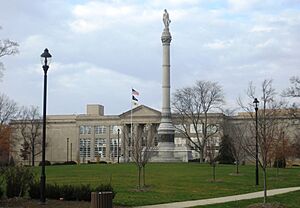
The Battle of Monmouth was not a clear win for either side in terms of gaining land. But it was a very important moral victory for the Continental Army. It proved that the American army could stand up to the British. This was true even against a larger, more experienced army. Washington's leadership and his soldiers' bravery became famous.
The American army had about 361 soldiers killed or wounded. The British had about 636 soldiers killed or wounded. The exact numbers are hard to know for sure.
The Battle of Monmouth showed the world that the American colonists could fight well. It proved that the British would not win easily. This made everyone in the colonies feel more hopeful. It reminded them that independence was still possible. It was a big step towards America winning the war.
Legacy of the Battle
The first time people acted out the battle was in 1828. This was done to support Andrew Jackson when he was running for president.
The Monmouth Battlefield State Park was opened in 1978, 200 years after the battle. A new visitor center opened in 2013. By 2015, the park covered over 1,800 acres. This included most of the land where the afternoon battle was fought. The state park helped people understand the true history of the battle better. The Continental Army now takes its proper place in the yearly reenactments held every June.
Images for kids
-
Baron Friedrich Wilhelm von Steuben by Charles Willson Peale
-
Major General Lafayette by Joseph-Désiré Court
See also
 In Spanish: Batalla de Monmouth para niños
In Spanish: Batalla de Monmouth para niños


